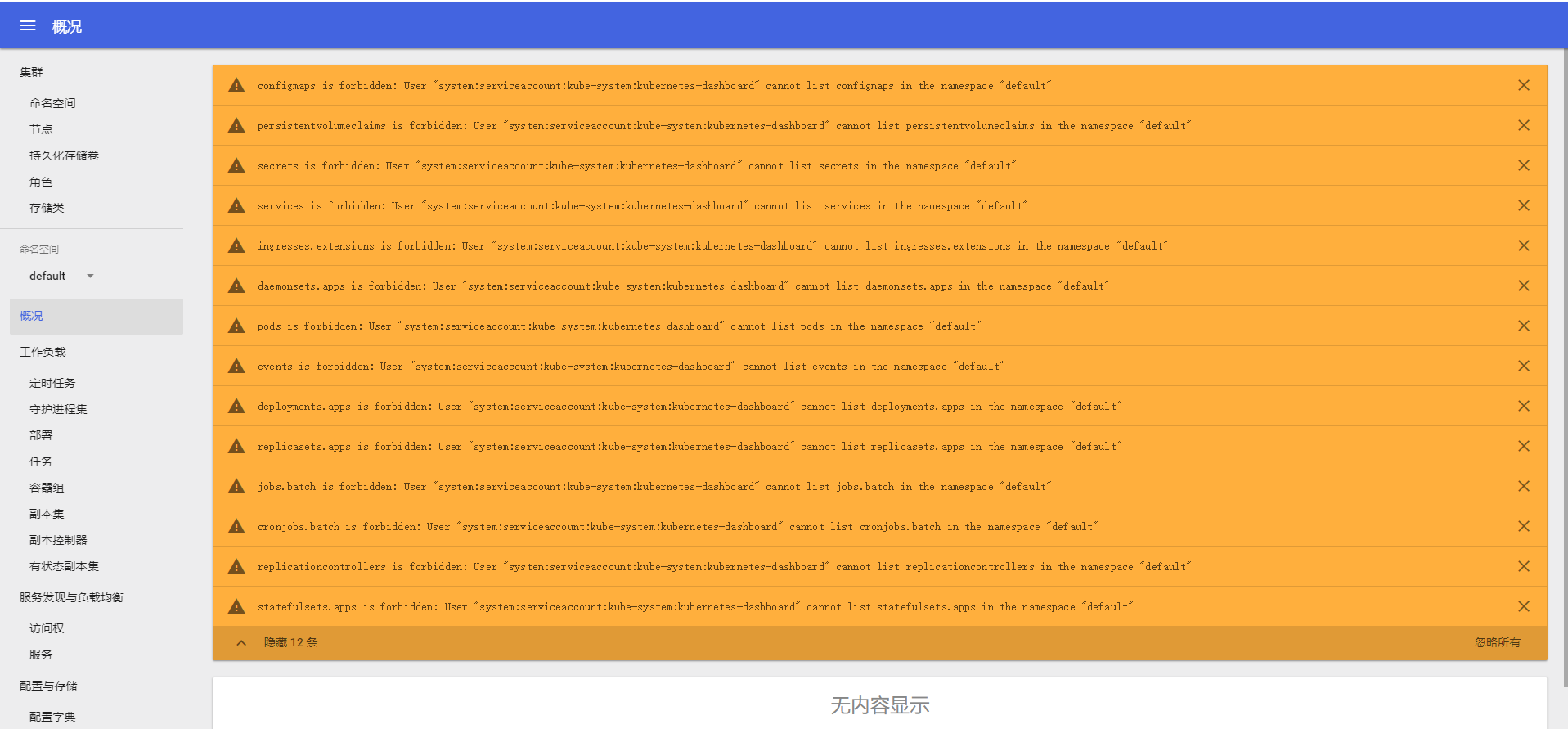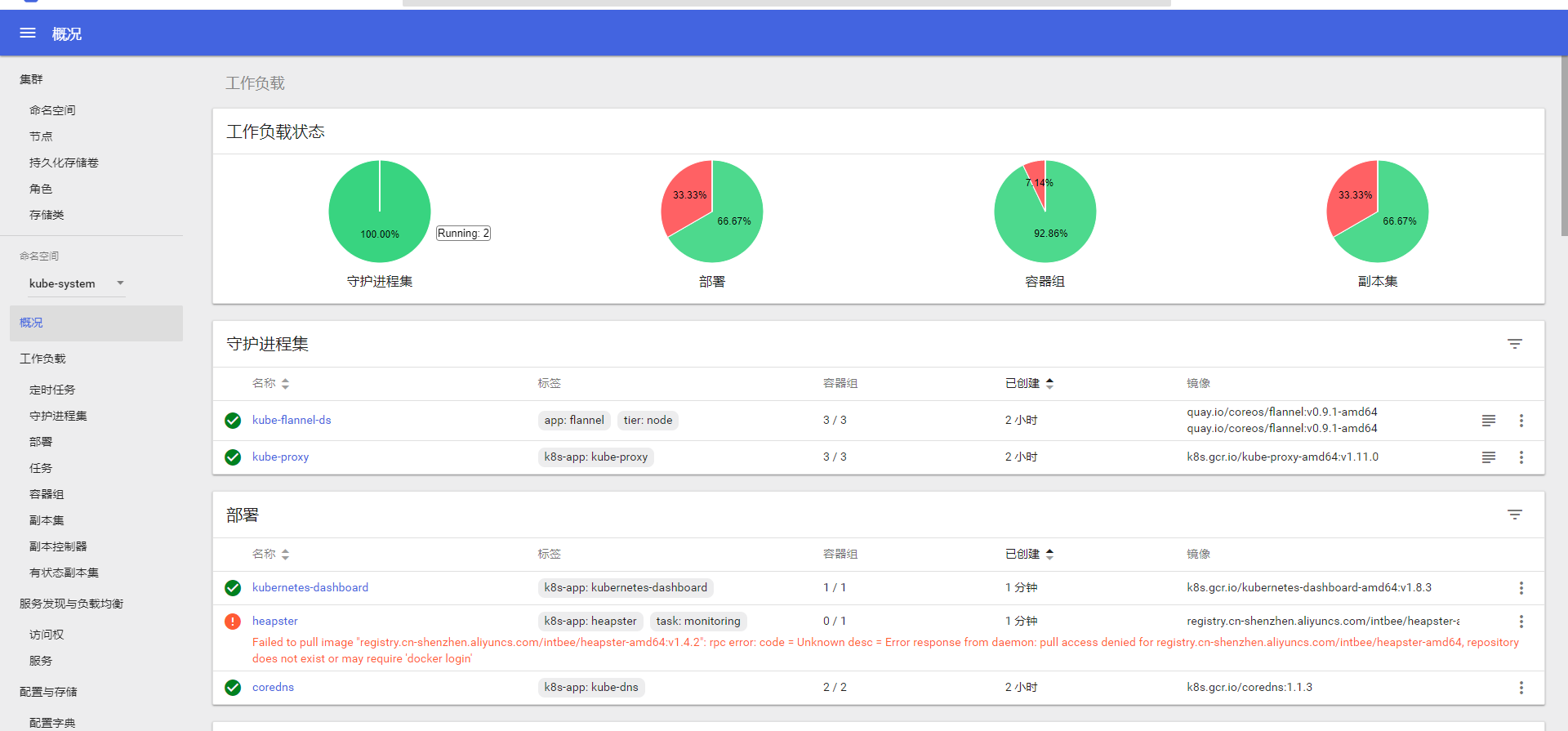0.引言
最近打算将现有项目的 Docker 部署到阿里云上面,但是之前是单机部署,现在阿里云上面有 3 台机器,所以想做一个 Docker 集群。之前考虑是用 Docker Swarm 来做这个事情的,不过后面看了一下现在 K8S 用的比较多,进而想在这三台机器上部署 K8S 集群。
下面附上 Kubernetes 介绍:
Kubernetes 是 Google 团队发起的开源项目,它的目标是管理跨多个主机的容器,提供基本的部署,维护以及运用伸缩,主要实现语言为 Go 语言。Kubernetes 是:
- 易学:轻量级,简单,容易理解
- 便携:支持公有云,私有云,混合云,以及多种云平台
- 可拓展:模块化,可插拔,支持钩子,可任意组合
- 自修复:自动重调度,自动重启,自动复制
看上去很牛掰的样子,下面我们就开始来部署吧。
1.准备工作
万事开头难,本来如果没墙的话就没有这么多破事,首先我们要先配置好安装 Kubernetes 所需要的必备环境,这里我没有采用从零开始安装 Kubernetes 的方式,而是使用了 Kubeadm 来进行 K8S 集群的安装与配置。
1.1 安装 Docker-CE
关于如何在 CentOS 安装 Docker-CE 的文章大家可以看一下我 这篇文章 ,几分钟的事情就可以安装完毕。
1.2 安装 Kubeadm
安装 Kubeadm 首先我们要配置好阿里云的国内源,执行如下命令:
1
2
3
4
5
6
7
|
cat <<EOF > /etc/yum.repos.d/kubernetes.repo
[kubernetes]
name=Kubernetes
baseurl=https://mirrors.aliyun.com/kubernetes/yum/repos/kubernetes-el7-x86_64
enabled=1
gpgcheck=0
EOF
|
之后呢,执行以下命令来重建 Yum 缓存:
1
2
3
|
yum -y install epel-release
yum clean all
yum makecache
|
下面就开始正式安装 Kubeadm 了:
1
|
yum -y install kubelet kubeadm kubectl kubernetes-cni
|
不出意外的话,安装完成之后,我们执行以下命令来启用 Kubeadm 服务:
1
|
systemctl enable kubelet && systemctl start kubelet
|
1.3 配置 Kubeadm 所用到的镜像
这里是重中之重,因为在国内的原因,无法访问到 Google 的镜像库,所以我们需要执行以下脚本来从 Docker Hub 仓库中获取相同的镜像,并且更改 TAG 让其变成与 Google 拉去镜像一致。
新建一个 Shell 脚本,填入以下代码之后保存。
1
2
3
4
5
6
7
8
9
10
11
|
#!/bin/bash
images=(kube-proxy-amd64:v1.11.0 kube-scheduler-amd64:v1.11.0 kube-controller-manager-amd64:v1.11.0 kube-apiserver-amd64:v1.11.0
etcd-amd64:3.2.18 coredns:1.1.3 pause-amd64:3.1 kubernetes-dashboard-amd64:v1.8.3 k8s-dns-sidecar-amd64:1.14.9 k8s-dns-kube-dns-amd64:1.14.9
k8s-dns-dnsmasq-nanny-amd64:1.14.9 )
for imageName in ${images[@]} ; do
docker pull keveon/$imageName
docker tag keveon/$imageName k8s.gcr.io/$imageName
docker rmi keveon/$imageName
done
# 个人新加的一句,V 1.11.0 必加
docker tag da86e6ba6ca1 k8s.gcr.io/pause:3.1
|
注:这里我就遇到过一个坑,原作者是根据 1.10 来的,然后在 kubeadm init 执行的时候一直报错,说找不到镜像。之后镜像版本是下载对了,但还是在 [init] this might take a minute or longer if the control plane images have to be pulled 这一句卡住,在国外的 VPS 测试之后,发现多了一个 k8s.gcr.io/pause:3.1 镜像,他的 ID 其实与 pause-amd64:3.1 一样,然后加了一个新的 TAG 之后,正常部署。
保存之后记得用 chmod 命令赋予 Shell 脚本可执行权限:
1.4 关闭 Swap
1
2
3
|
sudo swapoff -a
#要永久禁掉swap分区,打开如下文件注释掉swap那一行
# sudo vi /etc/fstab
|
1.5 关闭 SELinux
1
2
3
4
5
|
# 临时禁用selinux
# 永久关闭 修改/etc/sysconfig/selinux文件设置
sed -i 's/SELINUX=permissive/SELINUX=disabled/' /etc/sysconfig/selinux
# 这里按回车,下面是第二条命令
setenforce 0
|
1.6 配置转发参数
1
2
3
4
5
6
7
8
|
# 配置转发相关参数,否则可能会出错
cat <<EOF > /etc/sysctl.d/k8s.conf
net.bridge.bridge-nf-call-ip6tables = 1
net.bridge.bridge-nf-call-iptables = 1
vm.swappiness=0
EOF
# 这里按回车,下面是第二条命令
sysctl --system
|
2.【主机】正式安装 Kuberentes
如果你做好了准备工作,后面的一切都是小菜一碟。
2.1 初始化相关镜像
要初始化镜像,请运行以下命令:
1
|
kubeadm init --kubernetes-version=v1.11.0 --pod-network-cidr=10.244.0.0/16
|
前面是版本号,后面是你 POD 网络的 IP 段。
执行之后,你大概会得到与我相近的输出:
1
2
3
4
5
6
7
8
9
10
11
12
13
14
15
16
17
18
19
20
21
22
23
24
25
26
27
28
29
30
31
32
33
34
35
36
37
38
39
40
41
42
43
44
45
46
47
48
49
50
51
52
53
54
55
56
57
58
59
60
61
62
63
64
65
66
67
68
69
|
I0712 10:46:30.938979 13461 feature_gate.go:230] feature gates: &{map[]}
[init] using Kubernetes version: v1.11.0
[preflight] running pre-flight checks
I0712 10:46:30.961005 13461 kernel_validator.go:81] Validating kernel version
I0712 10:46:30.961061 13461 kernel_validator.go:96] Validating kernel config
[WARNING SystemVerification]: docker version is greater than the most recently validated version. Docker version: 18.03.1-ce. Max validated version: 17.03
[WARNING Hostname]: hostname "g2-apigateway" could not be reached
[WARNING Hostname]: hostname "g2-apigateway" lookup g2-apigateway on 100.100.2.138:53: no such host
[preflight/images] Pulling images required for setting up a Kubernetes cluster
[preflight/images] This might take a minute or two, depending on the speed of your internet connection
[preflight/images] You can also perform this action in beforehand using 'kubeadm config images pull'
[kubelet] Writing kubelet environment file with flags to file "/var/lib/kubelet/kubeadm-flags.env"
[kubelet] Writing kubelet configuration to file "/var/lib/kubelet/config.yaml"
[preflight] Activating the kubelet service
[certificates] Generated ca certificate and key.
[certificates] Generated apiserver certificate and key.
[certificates] apiserver serving cert is signed for DNS names [g2-apigateway kubernetes kubernetes.default kubernetes.default.svc kubernetes.default.svc.cluster.local] and IPs [10.96.0.1 172.16.8.62]
[certificates] Generated apiserver-kubelet-client certificate and key.
[certificates] Generated sa key and public key.
[certificates] Generated front-proxy-ca certificate and key.
[certificates] Generated front-proxy-client certificate and key.
[certificates] Generated etcd/ca certificate and key.
[certificates] Generated etcd/server certificate and key.
[certificates] etcd/server serving cert is signed for DNS names [g2-apigateway localhost] and IPs [127.0.0.1 ::1]
[certificates] Generated etcd/peer certificate and key.
[certificates] etcd/peer serving cert is signed for DNS names [g2-apigateway localhost] and IPs [172.16.8.62 127.0.0.1 ::1]
[certificates] Generated etcd/healthcheck-client certificate and key.
[certificates] Generated apiserver-etcd-client certificate and key.
[certificates] valid certificates and keys now exist in "/etc/kubernetes/pki"
[kubeconfig] Wrote KubeConfig file to disk: "/etc/kubernetes/admin.conf"
[kubeconfig] Wrote KubeConfig file to disk: "/etc/kubernetes/kubelet.conf"
[kubeconfig] Wrote KubeConfig file to disk: "/etc/kubernetes/controller-manager.conf"
[kubeconfig] Wrote KubeConfig file to disk: "/etc/kubernetes/scheduler.conf"
[controlplane] wrote Static Pod manifest for component kube-apiserver to "/etc/kubernetes/manifests/kube-apiserver.yaml"
[controlplane] wrote Static Pod manifest for component kube-controller-manager to "/etc/kubernetes/manifests/kube-controller-manager.yaml"
[controlplane] wrote Static Pod manifest for component kube-scheduler to "/etc/kubernetes/manifests/kube-scheduler.yaml"
[etcd] Wrote Static Pod manifest for a local etcd instance to "/etc/kubernetes/manifests/etcd.yaml"
[init] waiting for the kubelet to boot up the control plane as Static Pods from directory "/etc/kubernetes/manifests"
[init] this might take a minute or longer if the control plane images have to be pulled
[apiclient] All control plane components are healthy after 41.001672 seconds
[uploadconfig] storing the configuration used in ConfigMap "kubeadm-config" in the "kube-system" Namespace
[kubelet] Creating a ConfigMap "kubelet-config-1.11" in namespace kube-system with the configuration for the kubelets in the cluster
[markmaster] Marking the node g2-apigateway as master by adding the label "node-role.kubernetes.io/master=''"
[markmaster] Marking the node g2-apigateway as master by adding the taints [node-role.kubernetes.io/master:NoSchedule]
[patchnode] Uploading the CRI Socket information "/var/run/dockershim.sock" to the Node API object "g2-apigateway" as an annotation
[bootstraptoken] using token: o337m9.ceq32wg9g2gro7gx
[bootstraptoken] configured RBAC rules to allow Node Bootstrap tokens to post CSRs in order for nodes to get long term certificate credentials
[bootstraptoken] configured RBAC rules to allow the csrapprover controller automatically approve CSRs from a Node Bootstrap Token
[bootstraptoken] configured RBAC rules to allow certificate rotation for all node client certificates in the cluster
[bootstraptoken] creating the "cluster-info" ConfigMap in the "kube-public" namespace
[addons] Applied essential addon: CoreDNS
[addons] Applied essential addon: kube-proxy
Your Kubernetes master has initialized successfully!
To start using your cluster, you need to run the following as a regular user:
mkdir -p $HOME/.kube
sudo cp -i /etc/kubernetes/admin.conf $HOME/.kube/config
sudo chown $(id -u):$(id -g) $HOME/.kube/config
You should now deploy a pod network to the cluster.
Run "kubectl apply -f [podnetwork].yaml" with one of the options listed at:
https://kubernetes.io/docs/concepts/cluster-administration/addons/
You can now join any number of machines by running the following on each node
as root:
kubeadm join 172.16.8.62:6443 --token o337m9.ceq32wg9g2gro7gx --discovery-token-ca-cert-hash sha256:e8adc6dc2bbe6bd18569c73e4c0468b4652655e7c5c97209a9ec214beac55ea3
|
2.2 配置 kubectl 认证信息
1
2
3
|
export KUBECONFIG=/etc/kubernetes/admin.conf
# 如果你想持久化的话,直接执行以下命令【推荐】
echo "export KUBECONFIG=/etc/kubernetes/admin.conf" >> ~/.bash_profile
|
2.3 安装 Flannel 网络
请依次执行以下命令:
1
2
3
4
5
6
7
8
9
10
11
12
13
14
15
16
17
18
|
mkdir -p /etc/cni/net.d/
cat <<EOF> /etc/cni/net.d/10-flannel.conf
{
“name”: “cbr0”,
“type”: “flannel”,
“delegate”: {
“isDefaultGateway”: true
}
}
EOF
mkdir /usr/share/oci-umount/oci-umount.d -p
mkdir /run/flannel/
cat <<EOF> /run/flannel/subnet.env
FLANNEL_NETWORK=10.244.0.0/16
FLANNEL_SUBNET=10.244.1.0/24
FLANNEL_MTU=1450
FLANNEL_IPMASQ=true
EOF
|
最后,我们需要新建一个 flannel.yml 文件,内容如下:
1
2
3
4
5
6
7
8
9
10
11
12
13
14
15
16
17
18
19
20
21
22
23
24
25
26
27
28
29
30
31
32
33
34
35
36
37
38
39
40
41
42
43
44
45
46
47
48
49
50
51
52
53
54
55
56
57
58
59
60
61
62
63
64
65
66
67
68
69
70
71
72
73
74
75
76
77
78
79
80
81
82
83
84
85
86
87
88
89
90
91
92
93
94
95
96
97
98
99
100
101
102
103
104
105
106
107
108
109
110
111
112
113
114
115
116
117
118
119
120
121
122
123
124
125
126
127
128
129
130
131
132
133
134
135
136
137
|
---
kind: ClusterRole
apiVersion: rbac.authorization.k8s.io/v1beta1
metadata:
name: flannel
rules:
- apiGroups:
- ""
resources:
- pods
verbs:
- get
- apiGroups:
- ""
resources:
- nodes
verbs:
- list
- watch
- apiGroups:
- ""
resources:
- nodes/status
verbs:
- patch
---
kind: ClusterRoleBinding
apiVersion: rbac.authorization.k8s.io/v1beta1
metadata:
name: flannel
roleRef:
apiGroup: rbac.authorization.k8s.io
kind: ClusterRole
name: flannel
subjects:
- kind: ServiceAccount
name: flannel
namespace: kube-system
---
apiVersion: v1
kind: ServiceAccount
metadata:
name: flannel
namespace: kube-system
---
kind: ConfigMap
apiVersion: v1
metadata:
name: kube-flannel-cfg
namespace: kube-system
labels:
tier: node
app: flannel
data:
cni-conf.json: |
{
"name": "cbr0",
"type": "flannel",
"delegate": {
"isDefaultGateway": true
}
}
net-conf.json: |
{
"Network": "10.244.0.0/16",
"Backend": {
"Type": "vxlan"
}
}
---
apiVersion: extensions/v1beta1
kind: DaemonSet
metadata:
name: kube-flannel-ds
namespace: kube-system
labels:
tier: node
app: flannel
spec:
template:
metadata:
labels:
tier: node
app: flannel
spec:
hostNetwork: true
nodeSelector:
beta.kubernetes.io/arch: amd64
tolerations:
- key: node-role.kubernetes.io/master
operator: Exists
effect: NoSchedule
serviceAccountName: flannel
initContainers:
- name: install-cni
image: quay.io/coreos/flannel:v0.9.1-amd64
command:
- cp
args:
- -f
- /etc/kube-flannel/cni-conf.json
- /etc/cni/net.d/10-flannel.conf
volumeMounts:
- name: cni
mountPath: /etc/cni/net.d
- name: flannel-cfg
mountPath: /etc/kube-flannel/
containers:
- name: kube-flannel
image: quay.io/coreos/flannel:v0.9.1-amd64
command: [ "/opt/bin/flanneld", "--ip-masq", "--kube-subnet-mgr" ]
securityContext:
privileged: true
env:
- name: POD_NAME
valueFrom:
fieldRef:
fieldPath: metadata.name
- name: POD_NAMESPACE
valueFrom:
fieldRef:
fieldPath: metadata.namespace
volumeMounts:
- name: run
mountPath: /run
- name: flannel-cfg
mountPath: /etc/kube-flannel/
volumes:
- name: run
hostPath:
path: /run
- name: cni
hostPath:
path: /etc/cni/net.d
- name: flannel-cfg
configMap:
name: kube-flannel-cfg
|
执行:
1
|
kubectl create -f ./flannel.yml
|
执行完成之后,我们可以运行一下命令,查看现在的节点信息:
会得到类似于下面的输出:
1
2
|
NAME STATUS ROLES AGE VERSION
g2-master Ready master 46m v1.11.0
|
好了,我们主机已经配置完成。
3.【Node 节点】配置
Node 节点所需要做的都在 [准备工作](# 准备工作) 里面,做完之后直接执行刚刚主机输出的:
1
|
kubeadm join 172.16.8.62:6443 --token o337m9.ceq32wg9g2gro7gx --discovery-token-ca-cert-hash sha256:e8adc6dc2bbe6bd18569c73e4c0468b4652655e7c5c97209a9ec214beac55ea3
|
执行完就 OK 了。
然后我们回到 62 主机服务器,我刚刚在两个从属的服务器执行了以上命令,然后运行:
得到输出:
1
2
3
4
|
NAME STATUS ROLES AGE VERSION
g2-master Ready master 46m v1.11.0
g2-node1 Ready <none> 41m v1.11.0
g2-node2 Ready <none> 41m v1.11.0
|
4.Dashboard 配置
Kuberentes 配置 DashBoard 也不简单,当然你可以使用官方的 dashboard 的 yaml 文件进行部署,也可以使用 Mr.Devin 这位博主所提供的修改版,避免踩坑。
地址在:https://github.com/gh-Devin/kubernetes-dashboard,将这些 Yaml 文件下载下来,在其目录下(注意在 Yaml 文件所在目录),执行以下命令:
1
|
kubectl -n kube-system create -f .
|
启动 Dashboard 所需要的所有容器。
访问你 MASTER 主机的 IP:30090,可以看到如下界面:

会发现报错。。。看不到容器,这个时候你需要新建一个 dashboard-admin.yaml 文件,然后填充如下内容:
1
2
3
4
5
6
7
8
9
10
11
12
13
14
|
apiVersion: rbac.authorization.k8s.io/v1beta1
kind: ClusterRoleBinding
metadata:
name: kubernetes-dashboard
labels:
k8s-app: kubernetes-dashboard
roleRef:
apiGroup: rbac.authorization.k8s.io
kind: ClusterRole
name: cluster-admin
subjects:
- kind: ServiceAccount
name: kubernetes-dashboard
namespace: kube-system
|
填好之后呢,执行如下命令启动容器:
1
|
kubectl -f ./dashboard-admin.yaml create
|
再次访问,正常了。

5.结语
参考资料:https://www.kubernetes.org.cn/3805.html
Dashboard Web-UI 配置 :https://www.kubernetes.org.cn/3834.html
Dashboard 问题解决:https://medium.com/@osamasaad_94885/i-got-it-to-work-finally-27514babede3

